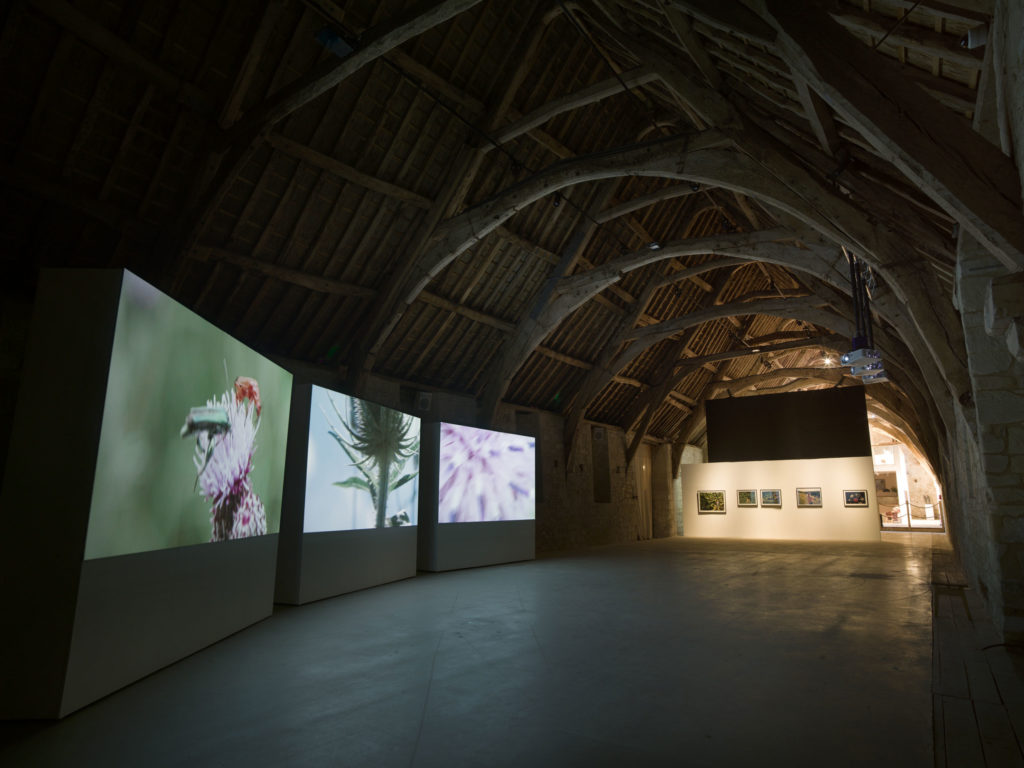
17 July – 5 September 2021
What Listening Knows creatively interrogates different concepts around the act of listening, particularly the concept of ‘the microphone’s gaze’, which shifts the idea of the ocular gaze, or camera gaze, into an acoustic dimension:
The project is built up around three individual performers acting as ‘field recordists’ in the landscape, trailing through cornfields, traversing unfathomable henges and earthworks, and scanning anthills and ancient forests. Each performer, armed with microphones and headphones, was prompted to physically interrogate the landscape from non-typical perspectives, activating their listening to find new ways to capture the acoustic forces of the environment.
Following these acoustic cues, Leber & Chesworth have developed a camera style detached from its ocular-centric perspective, imbued with an acoustic consciousness, at times tipping and rotating the landscape, levitating rocky masses, and trailing growths in the forest from both macro and micro perspectives.
Podcast interview: Sonia Leber and David Chesworth interviewed by journalist and presenter Fiona Gruber exactly one year after the start of their residency at Messums Wiltshire.
Film above: Sonia Leber and David Chesworth, What Listening Knows, 2021
3-channel 4K video, multi-channel audio (video stills and excerpts)
article by our Chief Curator, Catherine Milner featured in The Daily Telegraph
“Every primary school pupil should be taught Mozart!” screamed the newspaper headline of an article in March following the Government’s announcement that music was to become compulsory for all children. In 102 pages, it set out what musical knowledge children should be taught for each year of their school education up until the age of 14.
Compare that to the two sides of A4 that constitute the UK’s current National Curriculum for Art – last updated eight years ago. Primary school children should be encouraged, it says, to “produce creative work, exploring their ideas and recording their experiences”. But then it adds, “schools are not by law required to teach pencil, charcoal, paint, clay”.
Read more
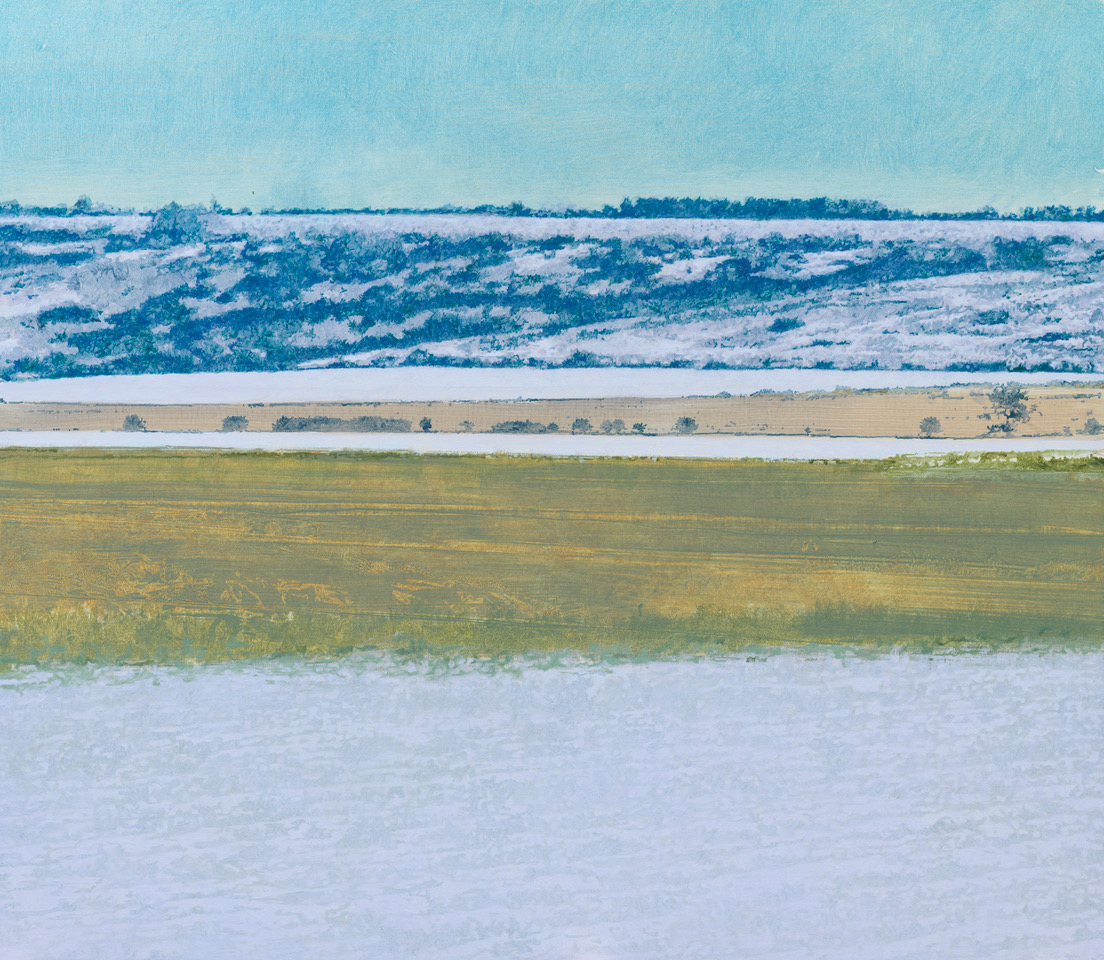
John Beard is an artist who has led an adventurous life, leaving Britain in the early 1980s to teach in western Australia, then settling in Sydney, while at the same time showing his work all over the world — in New York and Delhi, Madrid, Melbourne, New Zealand, London, Lisbon and St. Ives.
I first got to know him in the late 1990s, when a work of his, Wanganui Heads, was included in an exhibition at the National Portrait Gallery, Painting the Century, held to celebrate the millennium in 2000. In 2007, he won the Archibald Prize, the leading prize for portraiture in Australia and, in some ways, the world, since it is a prize of such long-established prestige, centre stage in the Australian art world in a way that the BP Portrait Award never has been. But he is not a portrait painter, any more than he is a landscape painter. He’s a painter of disappearing and sometimes ephemeral appearances — images which hover in a space somewhere between realism and abstraction, half real, half remembered, highly composed, but, at the same time, loosely brushed and ill-defined, not as seen, but touched, transmuted, as the ghost of physical appearances.
In the midst of this peripatetic and transient life, he arranged to rent a cottage in October 2020 in the heart of the Wiltshire countryside, due west of Salisbury, looking across fields and farmland towards a line of hills of the south Wiltshire Downs. Then came another COVID lockdown. He and his wife, Wendy, were trapped in Wiltshire by the epidemic, not allowed to meet people, not allowed to leave. They had only the view of the distant hills for company.
Out of this period of being stuck in the English countryside, he has produced a body of work which is intensely atmospheric and solitary, the landscape of fields and hills half seen, half absorbed into his imagination and then idealised into views of the snow and the mist, the wintry hills and the outlines of the distant trees along the horizon and the ploughed-up fields in diagonal lines stretched across the foreground, sometimes covered in a light dusting of snow.
He works in watercolour, too, as did Turner: watercolour which is such a wonderful medium for the depiction of atmosphere, because it is done at speed and cannot be over-worked. Again, you see the distant line of hills trailing off into the left-hand horizon; the evening light as the trees and fields merge, the only definition provided by the line of trees on the horizon, or, occasionally, one lone tree in the middle distance, providing an incident in an otherwise featureless landscape. Sometimes you can feel him sitting down and wanting to catch the last of the evening light in the watercolour.
Landscape is a difficult genre in the modern world, as is portraiture. It’s been too hackneyed, perverted by the ease and instantaneity of photography, so that it is hard to convey the restfulness of nothing, the subtleties of light, so ethereal, so liquid and imprecise.
Hovering, shimmering, transient. This is not conventional English landscape, but is instead both ordinary and epic at the same time; one piece of countryside, the south Wiltshire downs, seen over and over again as the months of COVID meant that there was no possibility of further exploration, only of enjoying and appreciating what is there — looking at it, thinking about it, visualising it, recording it, always the same, which for a period of time, six months, was all that he had to depict, no people to talk to, just fields and the distant line of downs.
Sir Charles Saumarez Smith CBE is a British cultural historian specialising in the history of art, design and architecture. He was the Secretary and Chief Executive of the Royal Academy of Arts from 2007 until 2018.
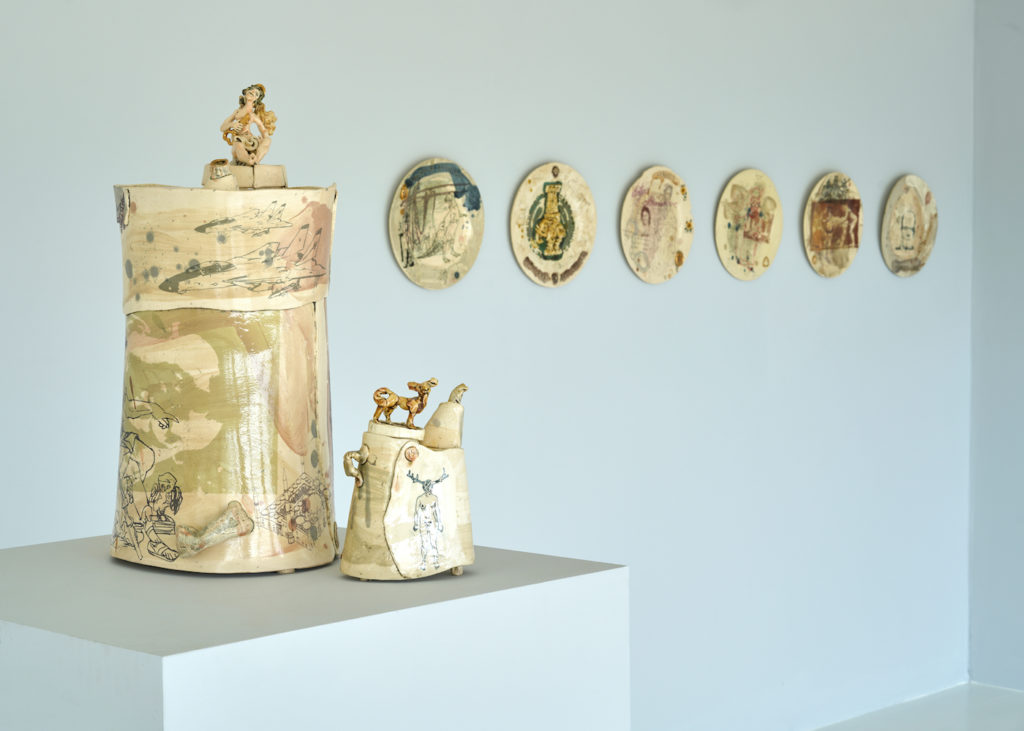
By Catherine Milner
Satire has always been a key feature of British art; from Hogarth to Spitting Image, Gillray to Banksy, artists in this country have for centuries lampooned hypocritical politicians or dim-witted dignitaries with glee.
In this respect, Stephen Dixon stands in an heroic tradition. But perhaps what makes him unusual is the scope of his savagery.
Unlike those artists from the past who mostly attacked British statesmen and British aristocracy while occasionally swiping at the French or Americans, Dixon takes aim at leaders from across the globe, from Donald Trump to Aung Sang Suu Kyi or when he was alive, Saddam Hussein.
His work targets the oil industry, the refugee crisis, slavery and asylum issues, echoing in his range, our change from imperialists to political activists and sometimes, bungling interventionists.
Born in 1957 in Peterlee in County Durham – a post-war town named after a social reformer bent on ending squalor – Dixon was steeped in politics from an early age; he is the son of a teacher who was an active member of the Labour Party and the grandson and nephew of a tribe of coal miners.
‘From the start I was never interested in making functional pieces, and more interested in telling stories and making statements’ he says.
One of the highlights of this show is a series of oil cans made in clay highlighting the folly of the Iraq War.
Although the same size as a real oil can, Dixon’s are wonky and plastered with images of Frankenstein – ciphers for the monster he thinks the West created in the Middle East with their initial support of Saddam Hussein – as well as icons of American audacity and derring-do like Charlton Heston pictured on a gas-guzzling motorbike.
Robustly modelled, with handles like cuffed ears, spouts like snouts and featuring an array of jaunty clay odalisques lying on top, these vessels have a strong physical presence that is complemented by the gauzy, photographic images wrapped like clothes around their trunks.
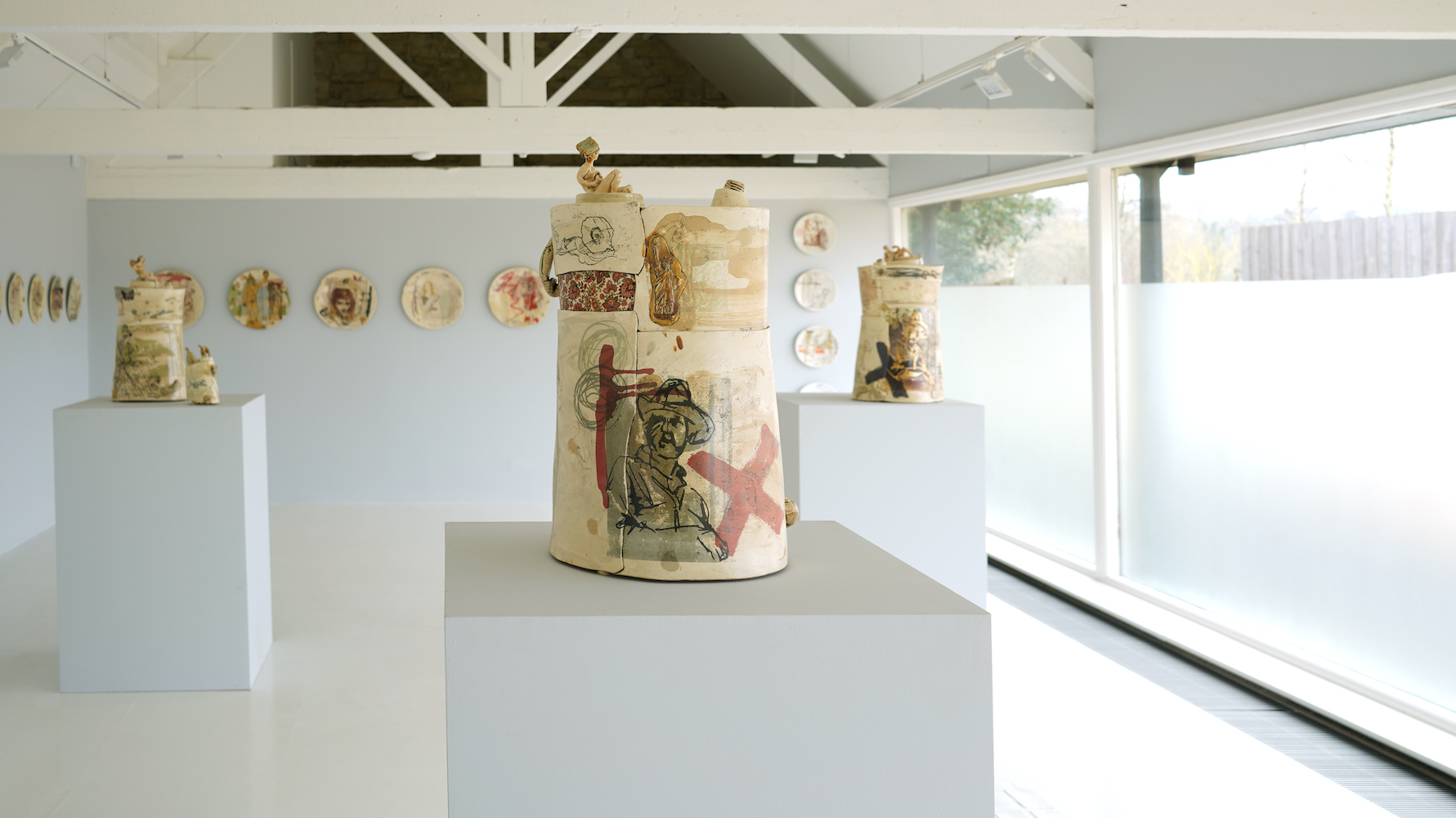
In works as bitingly accusatory as they are friendly to look at, icons of Eastern culture like the Kama Sutra, the tombs at Petra or the defaced Bamiyan Buddhas are superimposed with highlights of those from the West; the Laocoon, Michelangelo’s David and flocks of US fighter jets.
‘I want to draw attention to the highest and lowest forms of civilization in each kind of culture,’ explains Dixon.
Although more of a teapot than an oil canister, a particularly caustic piece in this show is a vessel decorated with a drawing of Diana, Princess of Wales presented as the Hunted rather than the Huntress with antlers on her head. Hounded by dogs Dixon has graphically drawn her womb – making the point that her main function was to bear an heir to the throne.
Another remarkable work decorated with a picture of a teenage girl brandishing a Kalashnikov is called 21 Countries – a reference to the number of nations bombed by the Americans since the Second World War.
It is not just America that seems to provoke Dixon’s ire, however. Recently he has turned his attention to the migrant crisis, seeing a parallel between the journey of Majolica – the tin glazed wares – and that of refugees.
Originally from North Africa Majolica spread through Italy, France and the Netherlands before finally arriving in England in the form of English Delftware.
In this exhibition are a series of tin-glazed plates which feature a dazzling array of contemporary hieroglyphs – both positive and negative. In no particular order appear some handcuffs, the lion and the unicorn coat of arms, a dominatrix holding a whip, Homer Simpson holding a trident, Donald Trump as a winged dinosaur; Carl von Ossietzky winner of the 1935 Nobel Peace Prize and perhaps most fittingly of all, a double portrait of Pandora, opener of the famous Box.
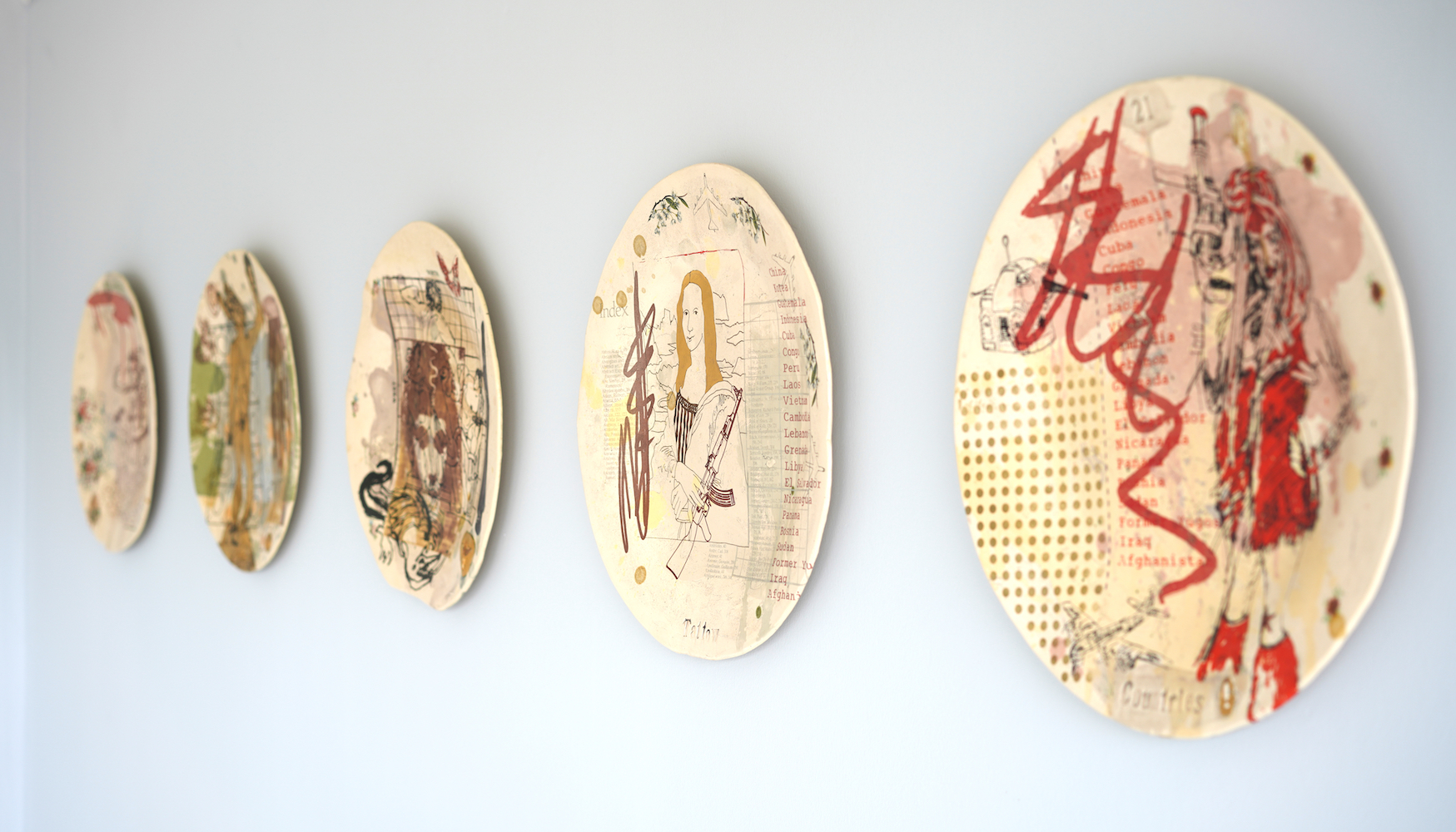
Having studied Fine Art at Newcastle University and Ceramics at the Royal College of Art in the 1980’s, Dixon became Senior Research Fellow in Contemporary Crafts at Manchester School of Art in 2003, becoming Department head and Professor of Contemporary Crafts since 2007.
Doggedly committed to a form of art that has been pretty unfashionable during the last fifty years, he has ploughed his own furrow with exceptional zeal, maximising the impact of his work by learning how best to apply water-based screen printed transfers to ceramics – attending universities and colleges in Edinburgh, Cork, Beirut, even Australia to become one of the world leading practitioners in this technique.
Dixon and Carol McNicoll – another questioning ceramicist also in this exhibition – and the likes of Grayson Perry and Edmund de Waal prove beyond doubt that contemporary painters, rightly lauded for their powerful polemic do not have the stage to themselves any more.
The difference is that contemporary ceramic can form the centrepiece of your table as well as your wall.
‘My career as a maker is defined by a commitment to politically engaged practice, and a belief in the power of craft to inform the public imagination and to make a difference,’ says Dixon.
In its technical skill, aesthetic and sensual allure and powerful narratives, Dixon’s work engages us on many levels chief of which seems to have been as a harbinger of the formidable new political age we have suddenly entered.

by Catherine Milner

Last November a record price for ceramic – £240,000 – was set for a pot by Magdalene Odundo, one of a group of ceramic artists that Messums are showing in March.
The clay pot has been a means of human survival for thousands of years; its decorations, engravings and embellishments offering an intimate record of how people have lived.
And although the market for the finest of ceramics still lags way behind that of the ‘fine art’ market and artists like Jeff Koons whose stainless steel Rabbit sculpture sold a couple of years ago for $91 million, the fact that they are being valued increasingly highly tell us a great deal about the seismic shift our culture is undergoing.
One might have expected a humble vessel made simply of clay to have become artistically obsolete with such a wide variety of technical innovations and novel materials available to artists.
But quite the contrary.
To generations brought up within an education system that prioritises working on computers rather than with their fingers and imagination, clay can seem exciting – almost anarchic.
Clay vessels reconnect the viewer with the ground beneath our feet; perfect ciphers for our new awareness of the fragility of the earth that like a pot itself, must be handled with care.
Over the last five years Messums has been tracing the evolution of this new movement with as many as thirty exhibitions and festivals focused on clay, culminating last year in Beyond the Vessel, one of the biggest exhibitions of contemporary clay sculptures to have been held anywhere in the world.
Shown firstly at the Mesher Gallery in Istanbul and then at Messums in Wiltshire, the exhibition brought together thirteen sculptors from seven European countries – each expressing different aspects of European myths and folklore in clay.
This exhibition brings us back to the vessel and highlights the pivotal role that the Royal College of Art in London has played in leading the renaissance of art using clay. Almost all the artists in it went to the RCA in the 1970’s ; a place that coupled the teaching of stringent technical disciplines with lively intellectual debate resulting in works that are exquisitely executed with compelling narratives to boot.
Having been educated in Kenya, the ‘narrative’ of Odundo’s work lies more in the shape and style of her works than any explicit drawings or words but a narrative is there nonetheless.
All her pieces, including the two we have on display, reveal the natural shapes of the human body – the pot belly, the curves of the spine, the hair – abstracted, burnished and formed into vessels.
A perfect piece of abstract art embodied in the most ancient form of utility.
‘Using the human form is a very natural way of sculpting with clay’ she says. ‘After all, the Bible says that God took clay and used it to form man. It’s something that is within our culture. The first thing you do as a child is get a piece of clay, squeeze it into your hand, add bits and pieces, then draw an eye or a mouth on to it. Clay automatically lends itself to making. It is embodied into the motion of making a body, a person.’
There are elements of human form in the works of Alison Britton too. Not only in the jug eared handles of her platters or the jaunty arms of some of her pots but in their uneasy stances; their craning necks or lopsided shoulders making them studies in the awkwardness of human beings for which clay acts as such a wonderful simulacrum. Not for her symmetrical forms and mathematical precision of some of the other pots in this show, but intuitive ‘flicks, squirts and slips.’
‘An unfired pot is naked; its needs something happening to it, like a body needs a dress,’ she says, challenging herself to make the painting on a pot in an unpremeditated fashion, less like patterning and more like an abstract painting in which the canvas is slabs of clay.
In Japan and Korea, ceramics represent a zenith of cultural expression, thanks to their ability to convey unique styles, customs, and politics within their form.
The Confucian ideals of frugality and purity has become a defining symbol of Korean and Japanese potters and running in tandem with our show of pots by British makers are works of the most exquisite perfection by Korean master Ree Soo-Jong and next month, by the Japanese artist, Makoto Kagoshima. A British equivalent is the work of Martin Smith, whose early works were large raku bowls which were precise and geometric, departing from the tradition of Japanese raku but keeping nonetheless their sense of purity.
His works in this exhibition play with perspective and reflection, surface and depth. Inspired by architecture they turn away from the malleability of clay, forcing it instead into angles of geometric precision.
Smith is Senior research Fellow of Ceramics at the RCA, where he is investigating
the ‘Potential of the Digitally Printed Ceramic Surface,’ and many of his works mimic other materials like wood, silver or gold in a way that clay objects have for centuries been skeuomorphs.
Although Steven Dixon has made several research trips to Japan, his way of working could not be more different, manifesting one of the enduring characteristics of British art – satire. From Hogarth to Spitting Image; Gillray to Grayson Perry, the British have always used wit to puncture authority and lampoon social vices.
He is currently working on a project that traces the history of Majolica; the type of tin-based glaze that is best known as coming from Italy but in fact originated in North Africa which spread throughout Europe until it appeared in England in the shape of English Delftware; using this trajectory of travel as a metaphor for the journey undertaken by refugees.
On one of his plates Mona Lisa brandishes a Kalashniko; on another, Michaelangelo’s David is woven with images of Palmyra after it was ruined by terrorists; totems from both ‘the highest and lowest points of civilisation,’ he says.
There are also a series of magnificent oil cans by Dixon made of clay, each standing at least 60 cms high and therefore actual size. They were made in the 1990’s during the time of the Iraq Wars and expose the hypocrisy of the West as it created a Frankenstein’s monster in the shape of Saddam Hussein and turned The Holy Land into a group of basket states.
Closer to home are the satirical works of Carol McNicoll, which include a ‘Non Socially Distanced’ Toby jug plastered with images of her friends, dancing, abseiling and sitting in the pub. She has also made a vase dedicated to the area of North London in which she lives called The Heath which subverts its reputation as a place for gay men to congregate by featuring an image of a bewigged and stockinged 18th century courtly gentleman bowing in front of a lady.
Back in ancient Greece pots recorded all sides of life from drinking games to gladiatorial wrestling matches to combing your hair. Thousands of years before that, they told us how Neolithic man worshiped, cooked and travelled around meeting with other tribes.
It is this ancestry of pots; their familiarity to us as domestic ally coupled with them being the nearest equivalent to our own bodies as vessels for our souls, that makes them particularly compelling at such a time of threat.
RELATED LINKS:
by Catherine Milner

Born in Reykjavík, Iceland, Haraldsdóttir’s works are inspired by Nordic pattern and folklore. Her family was originally from a small village on the Snaefellness Peninsular called Olafsvík in the shadow of the celebrated twin peaked glacial mountain that inspired Jules Verne’s novel Journey to the Centre of the Earth.
The patterns on her ceramics echo the distinctive black and white designs of Icelandic woollen garments, rugs and tapestries, inspired by snow, nets and other crystalline and geometric forms.
Having graduated with a Masters degree and the Silver Medal for Architecture from Glasgow School of Art she studied at the Hochschule der Kunst in Berlin before practising professionally as an architect in Reykjavik, Edinburgh and London.
 She turned to ceramics as a way of creating ‘small architecture’ in a hands-on manner in response to the bureaucracy and meetings with lawyers, legislators and engineers that comprises much of an architect’s day-to-day life.
She turned to ceramics as a way of creating ‘small architecture’ in a hands-on manner in response to the bureaucracy and meetings with lawyers, legislators and engineers that comprises much of an architect’s day-to-day life.
‘I have now worked as a ceramic artist for longer than it takes to become an architect’ she says. ‘Clay has replaced steel and glass, but I still work as I was trained; pieces are planned and drawn before they are made and made as they are conceived.’
Her sculptures are mostly built in stoneware clay and painted with slip; black on stoneware or sometimes white on lava stone. This is then scraped back to reveal the base material in two-tone monochrome patterns, occasionally joined by a mid-tone painted slip to create more complex geometries. The scrape marks are visible, and the surface is a plane of shallow relief, like an elaborate braille; the tactile nature of Haraldsdóttir’s work is important – they are an invitation to touch.
‘The works are a conversation between the pseudo -perfection of geometric pattern and the tactile impurity of hand-manipulated clay’ she says. ‘They are not sterile and porcelain-perfect but visceral mini monoliths, which have layers of complexity built into superficially simple constructions.’
She deliberately creates warped planes through careful pattern cutting and jointing of would-be flat slabs so that vessels become subtly off-kilter.
The strong patterns on them tend to anaesthetise first impressions that they are organically shaped and made from organic materials but the play of light, even across matt surfaces belies a more expressive form.
People are generally afraid of handling ceramics but Haraldsdóttir’s works invite quite the contrary reaction. She creates cushions of clay that sometimes encapsulate loose clay beads that create ‘roulette wheel’ sounds when held and handled.
‘Some of my pieces are ‘participative ceramics’ she explains;
‘I am particular about the cuts and punctures I make in my vessels. Letterbox openings allow the soul of each piece to come and go as they please.’
Interview by Crafts magazine

Crafts magazine: How does it feel to have won Blown Away, and what happens next?
Elliot Walker: It’s still sinking in. We actually filmed it a year ago, so I’ve had to keep shtum since then, but the past week has been crazy and I’ve had lots of support. People over here think it’s amazing that someone from the UK has won a US-based show.
As the winner of Blown Away, I was awarded a residency at the Corning Museum, which I’m hoping to do in the autumn, as well as another at the Pittsburgh glass centre. I’m hoping to use those to make work for an exhibition I have planned at the Habatat Galleries in Detroit, the flagship glass gallery in the US.
The American studio glass scene is much bigger than the UK’s. Did you notice a difference?
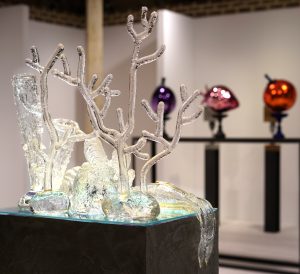 Yes, it’s unbelievably different there. One thing I learned is how many institutions they have dedicated to glass – a lot of them with charitable status, so people from underprivileged or challenging backgrounds can go and learn the craft. Glassblowing needs a lot of discipline so I can see how it might change your perspective or your emotional state. A lot of artist there make their work by doing projects with different institutions. I hope people in the UK can start to understand what we’re losing in terms of craft, heritage, history, skills and contemporary practice without publicly funded institutions for glass making.
Yes, it’s unbelievably different there. One thing I learned is how many institutions they have dedicated to glass – a lot of them with charitable status, so people from underprivileged or challenging backgrounds can go and learn the craft. Glassblowing needs a lot of discipline so I can see how it might change your perspective or your emotional state. A lot of artist there make their work by doing projects with different institutions. I hope people in the UK can start to understand what we’re losing in terms of craft, heritage, history, skills and contemporary practice without publicly funded institutions for glass making.
Why do you think you won the competition?
A lot of it was luck – the other contestants were fantastic. I think had the advantage of diversity – because I’m a sculptor more than traditional glassblower, I could come up with different forms quite easily, which gave me an edge.
In your current online exhibition with Messums London you’re showing a new body of work, ‘Plenty’. How does this series draw on traditional still-life paintings?
I’ve been working with glass for 12 years, always experimenting with different techniques. But I’m also influenced by historical works of art. Here, the 3D forms take inspiration from still-life paintings, their composition and depiction of expendable objects.
How do the works comment on our relationship to food?
I’ve been thinking about our idealised conception of food – how the farmed strawberries we eat are so unlike the tiny, seed-covered wild ones. For this show, I have made an enormous strawberry and used a mirroring technique to make it look obscene. Then there’s a triptych of seafood that uses clear glass to comment on the bleaching of coral reefs.
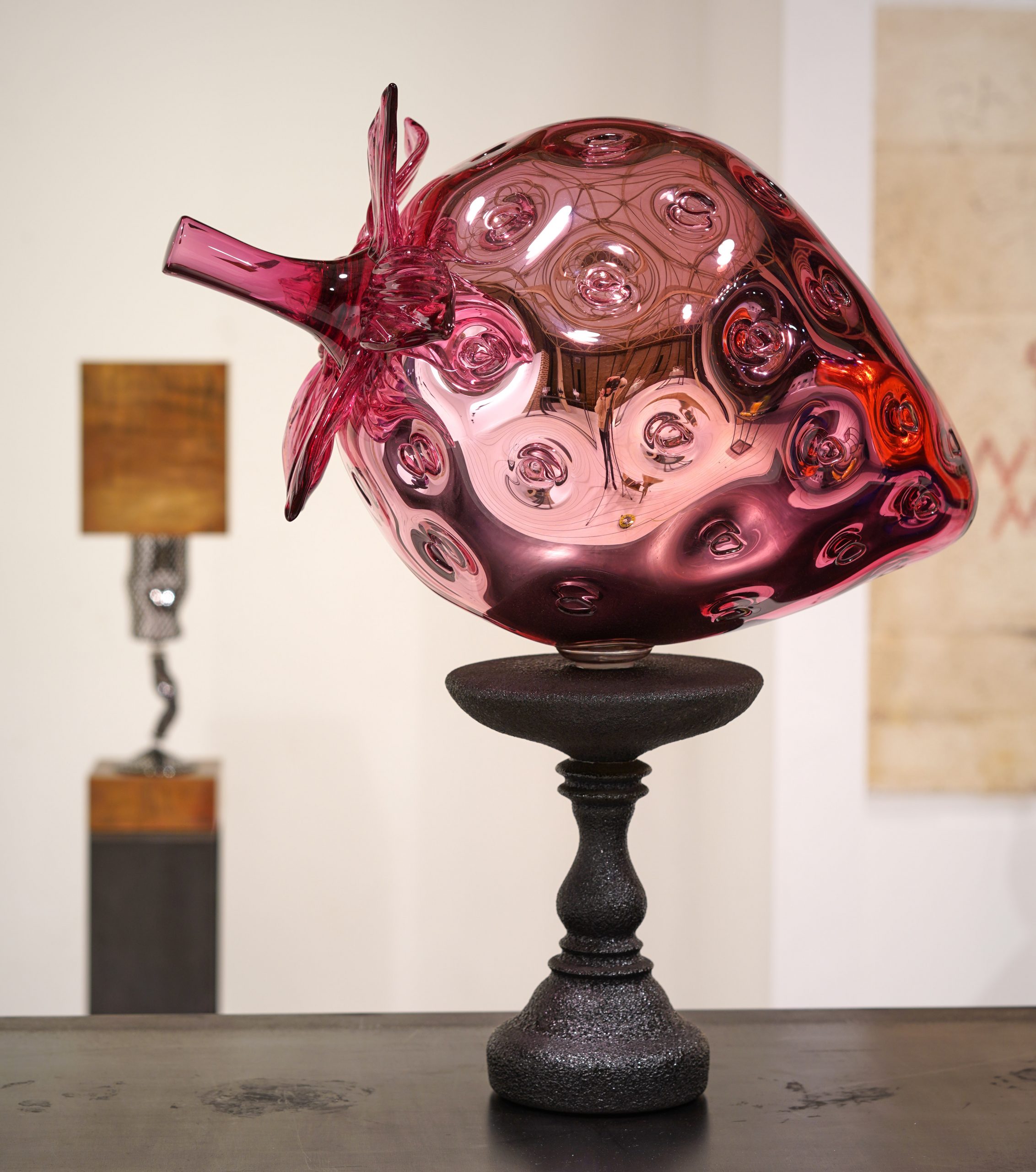 Could you tell me about the tableware in the display?
Could you tell me about the tableware in the display?
Goblet construction is the height of technical glassmaking, and glassmakers often display many identical ones together. I’ve turned that idea into a sculpture: I’ve made 20 wall-mounted goblets using the traditional reticello technique, but then crushed them down between two concrete blocks until they are distorted, and displayed them on the wall.
The virtual exhibition Elliot Walker: Plenty runs until 13 February. This interview is an updated extract from Crafts magazine’s January/February issue
Interview courtesy of the Crafts Council and Crafts magazine.
Read more about Elliot in The Telegraph
by Polly Pentreath
A white boat with a red hull looms out from a wash of deep brown. It is built of curved
wooden slats that turn a buttery yellow in the light and purple in the shadow. The darkest
shadows disappear into the deep brown of the background, while highlights are picked up in
turquoise. Jette is exemplary of James Dodds’ boat paintings, which show wooden vessels in
various stages of completion. The exact draughtsmanship shows James’ mastery of his
subject and they resemble architectural plans in their accuracy and precision. Yet his
paintings are more than recordings of the boat-building process. The vessels are viewed
from strange angles and suspended over great plains of colour. The underlying drawing is
filled in with unexpected combinations of colour and the surface scraped back with a palette
knife.
Jette is a Danish boat built in the USA. James has studied boats from all over the British Isles
but his reach extends far beyond our coastline. He approaches these boats like an
anthropologist, noticing the peculiarities and similarities of different regions and revealing
shared histories. He became interested in Danish boats after visiting the country and
observing similarities to boats in Norfolk. These resemblances originate with the historic
North Sea crossings of the Vikings and James goes further to contend that all clinker-built
boats around the British Isles are derived from Viking vessels.
The painting of Jette sits between a portrait of a living vessel or a plan of a boat to be.
Sketch lines are left visible, reminding us of the boat’s beginning on the drawing board.
These lines jar with the physicality the boat, which looms out over the viewer as if already
making way to the water. The light glaring on the side is real – bright sunlight on a clear day.
The distressed surface, scratched and scraped back with a palette knife, speaks to a lifetime
spent at sea. The whole history of this small boat is here; it’s ancestry in Denmark, the
drawn plans on paper, later the workshop, and years from now, it’s future at sea.
If you’d like to know more about James Dodds and his boats, sign up to our newsletter to be kept up to date

Our represented artist Charles Poulsen is featured in The Times newspaper this month. The image was chosen as one of the publications photographs of September 2020 and taken by James Glossop. The sculpture is Poulsen’s Skyboat an 11-metre wooden former fishing boat built in Whitby, which is now suspended on a wooden frame more than four metres in the air. The sculpture is created at Marchmont House in the Scottish borders and will eventually be supported by the oaks planted beneath it which will form a living cradle. The boat will appear to float and take up to 70 years to complete.
An exhibition of Charles’ 5ft square drawings will be shown at Messums Yorkshire from 31 October…read more
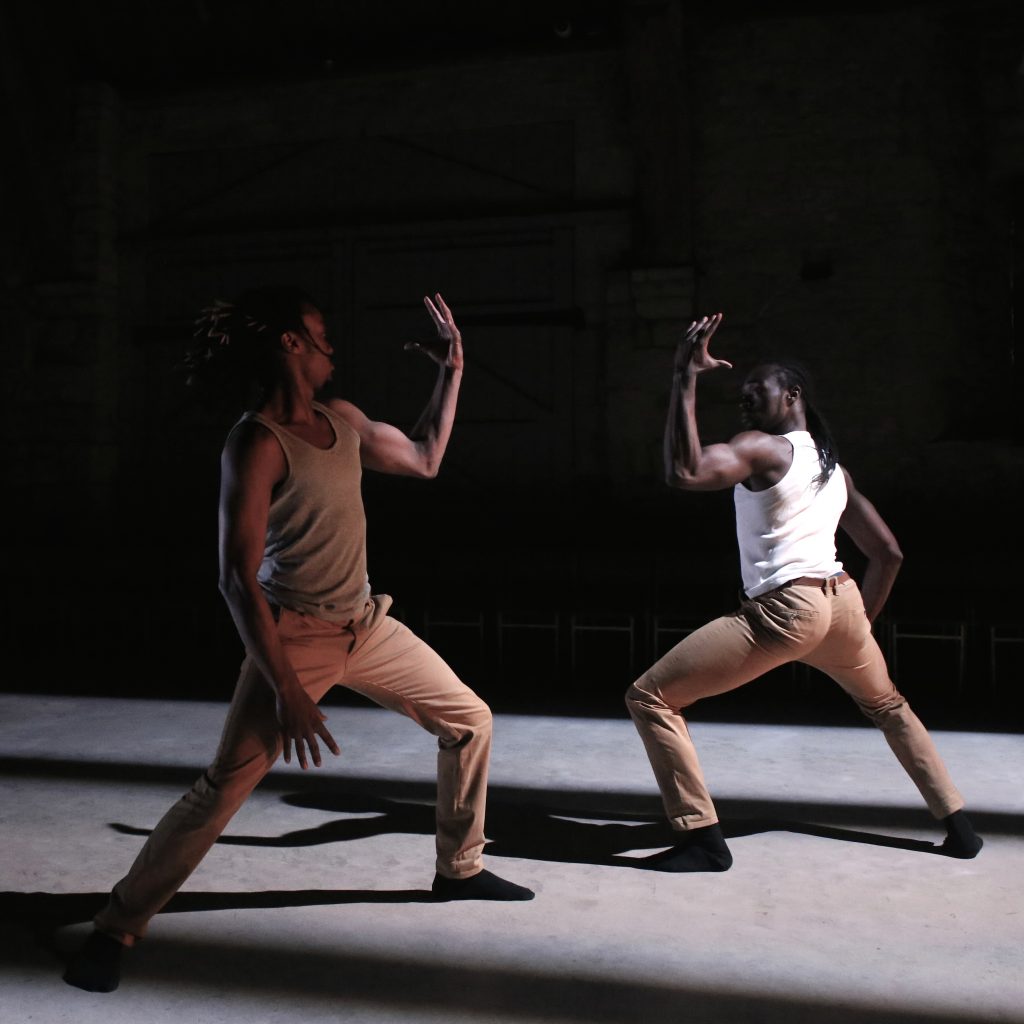
Performance Associate Anthony Matsena talks to Messums Wiltshire about Co-directing, choreographing and performing in lock down alongside his brother Kel and his plans for creating a film and live performance coming to Messums Wiltshire this September.
It has been an incredible year for Anthony Matsena. Following his sell-out performances here at the barn gallery, Anthony has been busy working on projects for the National Dance Company Wales and a brand new piece commissioned by Messums Wiltshire in response to the Elisabeth Frink studio – in situ at the gallery from Saturday 4 July. As with all our events at this time, the dance will now be performed online but Anthony will be here to introduce it to us ahead of time via Zoom.